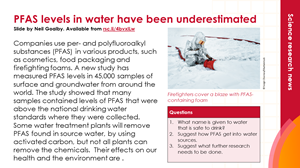Find out how forever chemicals taint water supplies globally
-

Download this
Use this story and the accompanying summary slide for a real-world context when studying potable water and its treatment with your 14–16 learners.
Download the story as MS Word or PDF and the summary slide as MS PowerPoint or PDF.
A new study has found that a substantial fraction of surface and groundwater around the globe contains levels of per- and polyfluoroalkyl substances (PFAS) above the national drinking water standards in the regions where they were collected.

What are PFAS?
Forever chemicals
PFAS are a group of around 14,000 synthetic organic compounds with multiple fluorine atoms attached to alkyl chains. Since the 1950s, companies have widely used PFAS in products including non-stick frying pans, clothing, furniture and firefighting foam due to the chemicals’ resistance to heat, water, grease and stains.
These chemicals have a dark side, though. The fluorine and carbon bond is extremely strong and as a result these compounds don’t degrade – in the environment or in our bodies. Scientists have linked a number of serious health conditions to PFAS in recent years, including testicular cancer, thyroid disease, infertility and developmental defects in unborn children.
These chemicals have a dark side, though. The fluorine and carbon bond is extremely strong and as a result these compounds don’t degrade – in the environment or in our bodies. Scientists have linked a number of serious health conditions (rsc.li/3wBaWh1) to PFAS in recent years, including testicular cancer, thyroid disease, infertility and developmental defects in unborn children.
Exceeding drinking water standards

An unpleasant surprise
The team found that 32% of groundwater and 16% of the surface water samples exceeded the national drinking water standards in some countries. ‘Drinking water standards vary around the world. In Australia, EU, the US and Canada,’ explains Denis O’Carroll, whose lab carried out the study, ‘the number of samples that exceeded those [limits] was somewhat surprising to us.’
This does not necessarily mean we are drinking water with such high levels of PFAS, however. Many water treatment plants are designed to reduce PFAS levels in water before it reaches our taps.
This article is adapted from Julia Robinson’s in Chemistry World.
Reference
D Ackerman Grunfeld et al, Nat. Geosci., 2024, 17, 340–346 (doi.org/10.1038/s41561-024-01402-8)
Download this
A starter slide to use with 14–16 year-old learners to provide context when studying potable water and its treatment: rsc.li/3QJ23sr
Downloads
PFAS in water student sheet
PDF, Size 0.24 mbPFAS in water student sheet
Handout | Word, Size 1 mbPFAS in water summary slide
Presentation | PDF, Size 0.65 mbPFAS in water summary slide
Presentation | PowerPoint, Size 2.31 mb














No comments yet